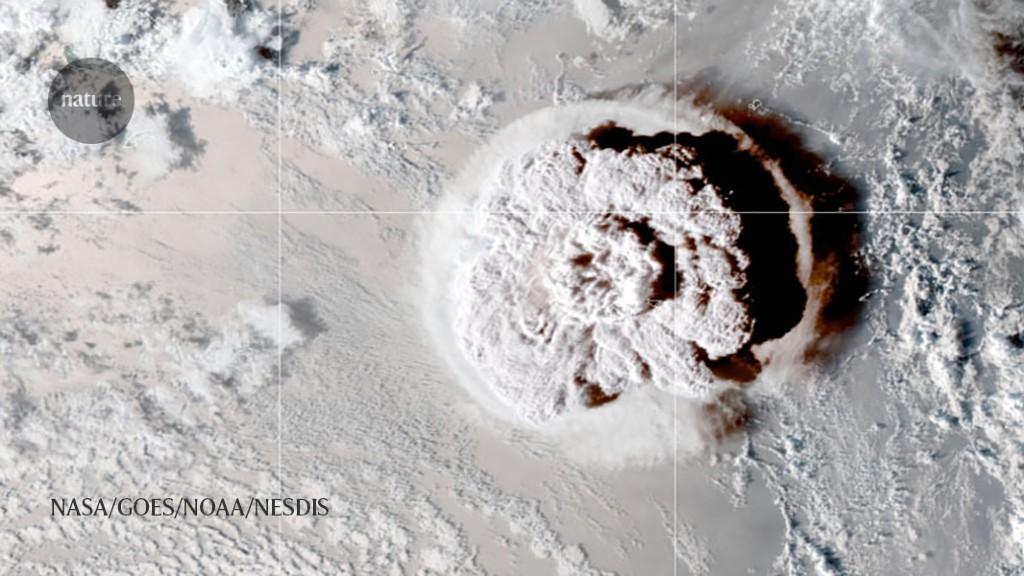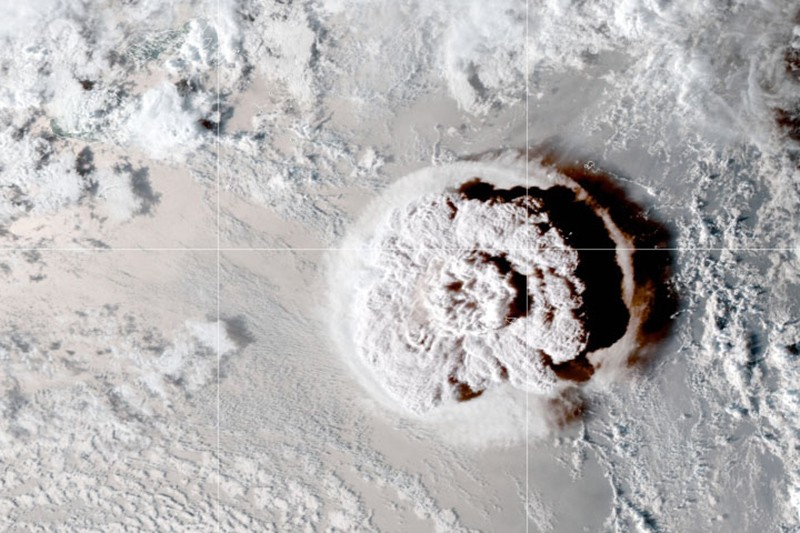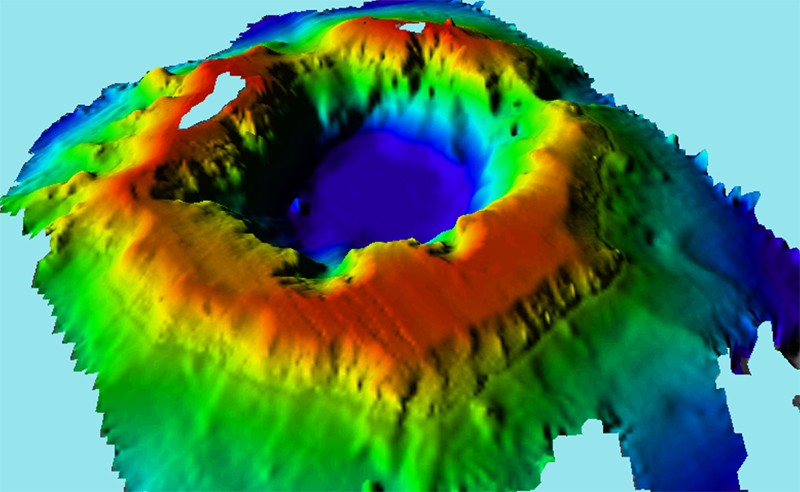Researchers are starting to piece together why the eruption of an underwater volcano in Tonga was so explosive — and what happened in the aftermath. Evidence gathered by two groups suggests that when the volcano’s centre collapsed, it spewed an enormous amount of magma that reacted violently with water, powering several large blasts and hundreds of much smaller explosions.
The Hunga Tonga–Hunga Haʻapai volcano erupted on 15 January 2022, producing the largest atmospheric explosion in recorded history. It sent shock waves around the world and a plume of ash into the upper atmosphere.
In May, Shane Cronin, a volcanologist at the University of Auckland, New Zealand, led a group that sailed over the volcano’s caldera, the central depression that forms when a volcano erupts, and used sonar to map its structure. They found the four-kilometre-wide caldera had dropped in depth from less than 200 metres below sea level to more than 850 metres.
“The volcano produced this enormous new caldera,” says Cronin. He estimates that some 6.5 cubic kilometres of rock were thrown out, roughly equivalent to a sphere as wide as the Golden Gate Bridge in San Francisco, California. “It was an amazing finding,” says Taaniela Kula, Tonga’s Deputy Secretary for Lands and Natural Resources in Nuku’alofa and a collaborator on the research. “It creates a better picture of the mechanism of the volcano.” The work was presented at a meeting of the European Geosciences Union (EGU) in Vienna on 26 May.
The reason for this large explosion was probably the interaction between large amounts of magma and water as the eruption began, says Cronin. “You’ve got 20-degree water and you’ve got 1,110-degree magma coming directly in contact,” he says. Such a large temperature difference meant that, as the water was forced into contact with the magma by the eruption, it exploded. Each interaction pushed the water deeper into the edges of the magma, says Cronin, increasing the surface area of contact and driving further explosions in a chain reaction.
The initial depth of the caldera was also just shallow enough that the water pressure did not suppress the blast, but deep enough that the magma was fed huge amounts of water to power the interactions, resulting in several large blasts and hundreds of much smaller explosions every minute. Eyewitness accounts from the day of the eruption reported “crackling and noise like artillery fire” as far as 90 kilometres from the eruption, says Cronin. “Those aren’t sounds I’ve heard from erupting volcanoes before,” he says.
Ash grains recovered from Tonga after the eruption also suggest that there was a violent interaction between magma and water. As the seawater came into contact with the magma, it produced shock waves powerful enough to fracture the grains, said Joali Paredes-Mariño, a geological engineer at the University of Auckland, in work presented at the EGU.
Wipe out
A separate expedition by a team at New Zealand’s National Institute for Water and Atmospheric Research (NIWA) in Auckland travelled to the volcano in April, but they did not go over the caldera. They sampled ash from the sea floor around the volcano, which showed that the eruption was probably followed by dramatic pyroclastic flows, hot streams of ash and lava that rained down over the submerged sides of the caldera. The onrushing hot ash turned the surrounding sea floor into a white desert that “wiped out everything”, says voyage leader Kevin Mackay, a marine geologist at NIWA.
These flows spread underwater for thousands of square kilometres from the eruption, ripping up sea-floor cables — including those providing Tonga’s access to the Internet, which has still not been fully restored — and powering tsunamis that washed over nearby islands, reaching up to 18 metres in height. On the sea floor, nothing seems to have survived, although samples are still being analysed to work out the extent of the damage. “We don’t even think bacteria is living there,” says Mackay. “That’s how toxic we think the sediment is.”
Samples collected by the NIWA team are being used to study potential impacts on ocean oxygen levels and ocean acidification, says Sarah Seabrook, a biogeochemist at NIWA.
Not everything was decimated, however. Satellite data showed a big bloom of phytoplankton in the ocean following the eruption, which fed on nutrients released by the blast, says Seabrook. And on nearby hills that jutted above the sea floor just 15 kilometres from the eruption, life was flourishing, says Mackay. “We expected life to be universally destroyed.”
Water-vapour plume
Other research presented at the EGU by Philippe Heinrich at the French Alternative Energies and Atomic Energy Commission near Paris showed that the pressure wave from the eruption produced a tsunami as far as the French Mediterranean coast, 17,000 kilometres away, with several centimetres in sea-level rise recorded. Luis Millán at NASA’s Jet Propulsion Laboratory in Pasadena, California, also found that the eruption sent up a water-vapour plume that reached a height of 53 kilometres, well into the stratosphere. This plume, which has now encircled the globe, increased the water-vapour content of the stratosphere by 146 teragrams (146 trillion grams), or 10%, and will probably remain in the atmosphere for at least a year. “We haven’t seen anything like this before in the entire satellite era,” says Millán.
Some research suggests there were hints of what was to come. Thomas Walter at the German Research Center for Geosciences in Potsdam says seismology readings point to a possible partial collapse of the caldera wall in the hours before the event. “It’s a very weak hint,” he says. “But it may indicate we have first a collapse and then the explosion.”
Cronin agrees that there might have been some forewarning. Satellite imagery showed part of the protruding northern rim of the volcano falling into the sea the day before the eruption. “It could have indicated early stages of the caldera collapse,” he says. That could be a crucial tool in predicting future submarine eruptions. “If we missed the big clue that this big one was coming, then that’s obviously a lesson we’ll take forward,” says Cronin.









More News
European ruling linking climate change to human rights could be a game changer — here’s how
Lethal AI weapons are here: how can we control them?
Ecologists: don’t lose touch with the joy of fieldwork